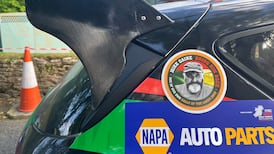A Kerrygold billboard showing Friesian cows in a pasture stands over a bustling black market money exchange at a roundabout in Goma, in Congo’s lawless east.
Every day, Isaac and other money changers gather under the billboard to calculate rates of exchange between the Congolese franc and the dollar in this border town.
“Kerrygold?” Isaac drops the “d” in his French-accented pronunciation. “I buy it for my kids. They always ask for it. Irlande?” he frowns in puzzlement, “Is it in Europe?”
An Irish visitor to Congo can't fail to be surprised by the Kerrygold advertising on display on TV and around Congolese cities. At a Goma roundabout, the metal stand on which a policeman directs traffic has a faded Kerrygold insignia. New billboards are going up every day.
"Savourez les bienfaits" is Kerrygold's latest slogan in Congo, "Savour the goodness". The Democratic Republic of Congo (DRC) is Kerrygold's fifth-largest market. "Our consumers are very middle class, very brand conscious," explains Iwan Brandsma, business development director for the Irish Dairy Board, which sells Kerrygold milk powder in Congo. "It's not baby formula. It's aimed at children, mums and families."
The Democratic Republic of Congo lies at the bottom of the UN’s human development index, one of the poorest countries in the world. Eastern Congo has a temperate climate. It rains throughout the year, the region is at high altitude and has a rich, deep red soil.
These are ideal conditions for dairy production and, after independence from Belgium in 1960, Congo developed a flourishing dairy industry.
Several provinces in the east of Congo built up large numbers of cattle after the country became independent from Belgium in 1960. By 1980, there were, for example, 275,000 cattle in the province of North Kivu, according to the UN.
Conflict
North Kivu's provincial capital Goma had a sophisticated refrigerated abattoir system to keep beef in storage, in preparation for transport on several daily flights which supplied Congo's major cities. The region of Masisi produced a hard, Gouda-like cheese which was distributed along well-maintained roads to urban centres, as well as being exported to neighbouring Uganda and Rwanda.
But the conflict which started in the early 1990s put an end to this fledgling industry. Herds have been decimated by roving militias, laboratories and dairies looted and most roads to the mountainous dairy regions are barely passable today.
The number of cattle in the province of North Kivu fell from 275,000 to just over 36,000 between 1980 and 1998, according to the Food and Agricultural Organisation.
Today, rounds of cheese from Lushebere parish farm are delivered by a priest who drives a van down a treacherous mountain road, arriving once a week to supply a small market in Goma.
The city’s sophisticated abattoir is no longer able to function on Goma’s erratic electricity supply and Congo’s dairy industry is barely surviving.
In the meantime, Kerrygold is booming in the country. Profits at its parent company, the Irish Dairy Board, are up, at €16.3 million, with sales of just over €2 billion around the world. The Irish Dairy Board declined to provide sales figures for Congo however.
Kerrygold is the biggest-selling milk powder brand in the country and, as the fifth-largest market for the brand, it is a very significant product for the company which sells milk powder in 400g cans and in sachets.
Congo is just one of the target countries for IDB market expansion after 2015 when the milk quota ends. By 2020, IDB aims to have increased production by 50 per cent with accelerated growth in new markets, including in Africa.
"More babies are born in DRC than in the US," says Brandsma. "That's such a staggering statistic. We underestimate the relevance of Africa as a powerhouse in business."
Irish Aid
Side-by-side with the Irish Dairy Board's commercial expansion in Congo is Irish Aid's contribution to meet humanitarian needs there.
In 2012, Irish Aid provided more than €10 million in emergency and long-term funding. So far this year, €3.8 million has been allocated to the country.
The humanitarian needs are immense – the death toll in what has become known as “Africa’s World War” is estimated to be 6 million.
There are 2.6 million people, who were forced to flee their homes, living in camps around eastern Congo while many thousands live in a state of flux, fleeing back and forth across borders as militias take advantage of poor security to target civilian populations across the region.
The Democratic Republic of Congo may be at a turning point – a new UN intervention brigade of 3,000 soldiers is massing in Goma with a mandate to “neutralise” armed groups.
Mary Robinson has just been appointed UN special envoy for the region, a tough task dealing with complex relations between Congo and its neighbours.
If the security situation improves, rebel groups are reduced and roads are rebuilt, then maybe Congo’s economic development will re-start and the dairy industry will get back on its feet.
But whether it will be able to compete with imported dairy products remains to be seen.
This project was made with the support of the Simon Cumbers Media Fund













